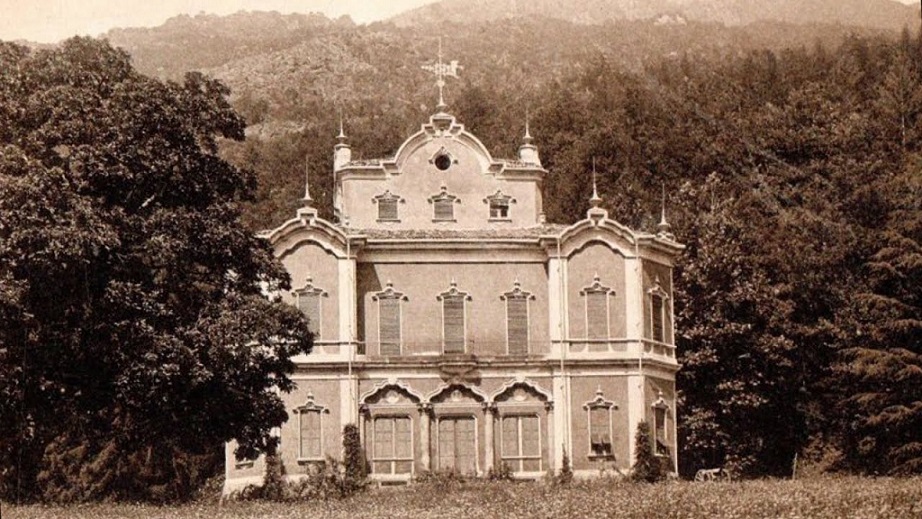I’ve always had a penchant for the mysterious and the unknown and I love listening to podcasts – much more, in fact, than I enjoy watching television. So, among the myriad I lend my ears to, there is one I particularly enjoy, hosted by two friends from Texas, whose tales traverse the eerie and the paranormal across the globe. A while back, my ears perked up at the title of one of their episodes — La Casa Rossa, which they defined as “the most haunted place of Earth.” Now, the intrigue was twofold, because not only did the episode venture into the haunting lore of my homeland, Italy, but it was centered around a place I knew, Villa de Vecchi, a well-known spot to all spook-attracted Italians, also known as – you guessed it – “the red house.”
Villa de Vecchi, often referred to as “Casa Rossa” due to its original red color, is a haunting relic of the past in Cortenova, near Lake Como. Built between 1854 and 1857 as a summer residence for Count Felix de Vecchi, a heroic figure from the Italian National Guard known for his role in the Five Days of Milan, the villa has since been swathed in a series of eerie legends and historical metamorphoses.
The architectural grandeur of Villa de Vecchi was conceived by Alessandro Sidoli, who intertwined Baroque and Classical Eastern styles to erect a dwelling that mirrored the Count’s refined and well-traveled persona. The architectural ambitions of the Count, especially his aspiration for an astronomical observatory, reflect a forward-thinking vision, yet also a hint of hubris: the observatory that never came to fruition is almost like a metaphor for the Count’s larger-than-life ambitions, perhaps overshadowed by the political and social turmoil of the time.
The eerie legends that have enveloped Villa de Vecchi over the centuries, ranging from gruesome familial tragedies to rumored satanic rituals purportedly conducted by Alistair Crowley, add a supernatural layer to its historical fabric. These tales, whether embellished or entirely fictitious, have turned the villa into a place of intrigue and fear and boosted its reputation as a haunted house.
Legends say that, in 1862, the Count discovered his wife murdered and his daughter vanished within the villa’s solemn chambers, driving him to suicide, reason for which the place would be haunted today. However, historical scrutiny has largely debunked this tale, revealing that the Count was already a widower battling liver ailments when he moved into the villa.
Over the years, Villa De Vecchi’s façade crumbled, but its appeal to both curious and paranormal enthusiasts burgeoned. We mentioned notorious British occultist Alistair Crowley, so let’s delve into his rumored presence here in the 1920s, which cast a longer, darker shadow over the villa’s already ominous narrative. Well, the truth is that Crowley’s dalliances within the villa’s haunting halls remain shrouded in mystery, as he was known to have established his occult abode, the Abbey of Thelema, in Sicily, and not in the enigmatic corners of Casa Rossa.
As the villa transitioned through the hands of different owners, from the De Vecchi family to the Medici of Marignano, and later to local entrepreneurs, its grandeur faded into oblivion. Despite the waves of time leaving it abandoned and vandalized, the villa’s spectral legacy thrived, as whispers of ghostly piano tunes and feminine voices echoed through its desolate halls, etching its name as Italy’s most haunted house in the annals of the paranormal.
The aesthetic glory of Villa de Vecchi, from its sumptuous murals to its expansive lands stretching across 13,000 acres, now lies buried beneath layers of graffiti and the relentless grasp of nature. The villa tells a melancholic story that moves from the tangible to the ethereal, and where the echoes of its long-lost opulence can somehow still be felt and seen in the ghostly lore that shrouds its crumbling façade. And so, among tales of horror and historical wealth, Villa de Vecchi stands as an aching symbol of the inexorable march of time, and people’s eternal attraction to the unknown.
Ho sempre avuto un debole per il misterioso e l’ignoto e amo ascoltare i podcast, molto più di quanto mi piaccia guardare la televisione. Quindi, tra la miriade di racconti a cui presto ascolto, ce n’è uno che mi piace particolarmente, condotto da due amici del Texas, i cui racconti attraversano l’inquietante e il paranormale in tutto il mondo. Tempo fa mi si sono drizzate le orecchie al titolo di una loro puntata: La Casa Rossa, che definivano “il luogo più infestato della Terra”. Ora, l’intrigo era duplice, perché non solo l’episodio si avventurava nella tradizione inquietante della mia terra natale, l’Italia, ma era incentrato su un luogo che conoscevo, Villa de Vecchi, un luogo ben noto a tutti gli italiani attratti dai fantasmi, e conosciuta anche come – avete indovinato – “la Casa Rossa”.
Villa de Vecchi, spesso chiamata “Casa Rossa” per il suo originale colore rosso, è un’inquietante reliquia del passato a Cortenova, vicino al Lago di Como. Costruita tra il 1854 e il 1857 come residenza estiva del conte Felice de Vecchi, figura eroica della Guardia Nazionale italiana nota per il suo ruolo nelle Cinque Giornate di Milano, la villa è stata da allora avvolta in una serie di inquietanti leggende e metamorfosi storiche.
La grandiosità architettonica di Villa de Vecchi fu concepita da Alessandro Sidoli, che intrecciò lo stile barocco e quello classico orientale per erigere una dimora che rispecchiasse la personalità raffinata e viaggiatrice del Conte. Le ambizioni architettoniche del Conte, in particolare la sua aspirazione ad un osservatorio astronomico, riflettono una visione lungimirante, ma anche un pizzico di arroganza: l’osservatorio mai realizzato è quasi una metafora delle ambizioni esagerate del Conte, forse messo in ombra dalle turbolenze politiche e sociali dell’epoca.
Le inquietanti leggende che hanno avvolto Villa de Vecchi nel corso dei secoli, dalle raccapriccianti tragedie familiari ai presunti rituali satanici presumibilmente condotti da Alistair Crowley, aggiungono uno strato soprannaturale al suo tessuto storico. Questi racconti, abbelliti o del tutto fittizi, hanno trasformato la villa in un luogo di intrighi e paure e hanno rafforzato la sua reputazione di casa infestata.
La leggenda racconta che, nel 1862, il Conte scoprì la moglie assassinata e la figlia scomparsa dalle solenni stanze della villa, spingendolo al suicidio, motivo per cui oggi il luogo sarebbe infestato. Tuttavia, l’esame storico ha ampiamente smentito questa leggenda, rivelando che il Conte era già vedovo e lottava contro disturbi al fegato quando si trasferì nella villa.
Nel corso degli anni, la facciata di Villa De Vecchi crollò, ma il suo fascino sia per i curiosi che per gli appassionati del paranormale aumentò. Abbiamo menzionato il famigerato occultista britannico Alistair Crowley, quindi approfondiamo la sua presunta presenza qui negli anni ’20, che gettò un’ombra più lunga e più oscura sulla già inquietante narrativa della villa. Ebbene, la verità è che le avventure di Crowley all’interno delle sale infestate della villa rimangono avvolte nel mistero, poiché era noto che avesse stabilito la sua dimora occulta, l’Abbazia di Thelema, in Sicilia, e non negli angoli enigmatici di Casa Rossa.
Quando la villa passò di mano in mano a diversi proprietari, dalla famiglia De Vecchi ai Medici di Marignano, e successivamente a imprenditori locali, la sua grandezza svanì nell’oblio. Nonostante le ondate del tempo l’abbiano lasciata abbandonata e vandalizzata, l’eredità spettrale della villa prosperò, mentre sussurri di melodie spettrali di pianoforte e voci femminili echeggiavano attraverso le sale desolate, incidendo il suo nome come la casa più infestata d’Italia negli annali del paranormale.
La gloria estetica di Villa de Vecchi, dai suoi sontuosi murales alle sue vaste terre che si estendono su 13.000 acri, ora giace sepolta sotto strati di graffiti e l’implacabile presa della natura. La villa racconta una storia malinconica che passa dal tangibile all’etereo, e dove gli echi della sua opulenza perduta da tempo possono in qualche modo ancora essere sentiti e visti nella tradizione spettrale che avvolge la facciata fatiscente. E così, tra racconti di orrore e ricchezza storica, Villa de Vecchi si erge come un simbolo doloroso dell’inesorabile scorrere del tempo e dell’eterna attrazione delle persone verso l’ignoto.




























